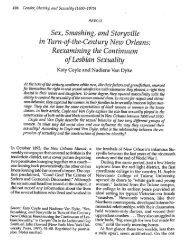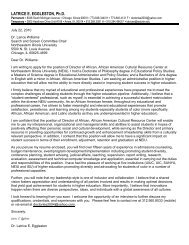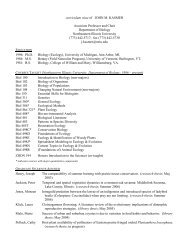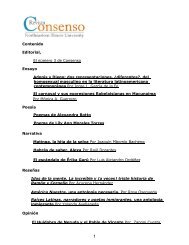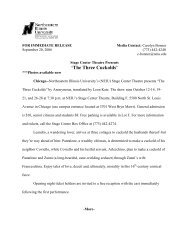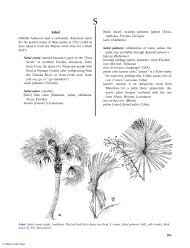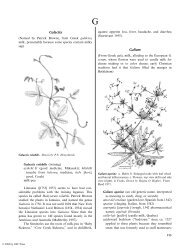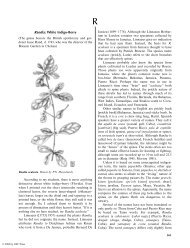Herba Cana - Northeastern Illinois University
Herba Cana - Northeastern Illinois University
Herba Cana - Northeastern Illinois University
You also want an ePaper? Increase the reach of your titles
YUMPU automatically turns print PDFs into web optimized ePapers that Google loves.
© 2004 by CRC Press<br />
The Ethnobotany 525<br />
Pluchea: Cure-for-All<br />
(Named to commemorate the French abbot Noël-<br />
Antoine Pluche, 1688 /1761, a seminary teacher and<br />
naturalist)<br />
In 1817, the French botanist Alexandre Henri<br />
Gabriel de Cassini (1781 /1832), who specialized in the<br />
Asteraceae, described plants in a new genus he called<br />
Pluchea. The reference species (type) of the genus is<br />
Pluchea marilandica, which another French botanist,<br />
André Michaux, previously had placed in the genus<br />
Conyza. Indeed, Michaux was following Linnaeus who<br />
placed in Conyza several species that today are<br />
segregated into other lineages.<br />
Such changing of names is a normal part of<br />
scientific learning because evolution has selected<br />
among different phylogenies to the point that they<br />
are difficult to distinguish. Not only have scientists<br />
had trouble sorting out the genera and species in the<br />
Asteraceae, but nonscientists sometimes apply names<br />
in what appear to be random ways. However, there are<br />
two frequent and essentially tropical Pluchea that<br />
people use across their ranges. Of the five native<br />
species in Florida, this discussion focuses on P.<br />
carolinensis and P. odorata. The second of these also<br />
appears in the literature under the names P. purpurascens<br />
and P. symphytifolia (Gillis 1977, Khan and<br />
Jarvis 1989), so it is often difficult to sort out uses.<br />
Since both species have mostly the same applications,<br />
exact identity is not critical.<br />
Only two indigenous common names were found<br />
in the southeast. The Choctaw call P. foetida hoshukkosona<br />
(haskuk, grass, kosoma, strong smell), and they<br />
boiled the leaves and used the water extract ‘‘during<br />
attacks of fever’’ (Bushnell 1909). The Koasati call P.<br />
camphorata ittohapakó (ittó, tree, hapakó, death), and<br />
also used it to treat fever (Taylor 1940). Given the<br />
importance of the plants to the remaining Americans,<br />
other linguistic groups probably also had names for<br />
them.<br />
In Mexico, the Aztecs knew these plants and used<br />
them. Both P. carolinensis and P. odorata were known<br />
as ciguapatle [ciguabate, cichapatle, cipatle, seguapeti,<br />
siguapete, siguapote], a name derived from cigua,<br />
woman, patl, medicine (Náhuatl, Mexico to El<br />
Salvador). However, alternate names were applied.<br />
Pluchea. Pluchea foetida (left). From Britton and Brown 1898. Pluchea odorata (right). a. Tip of flowering branch.<br />
b. Enlargement of leaf showing glandular pubescence. c. Flower head, side view. d. Perfect disk flower, side view. e. Perfect disk<br />
flower, longitudinally dissected. f. Floral diagram of perfect disk flower. g. Pistillate disk flower, side view. h. Pistillate disk<br />
flower, longitudinally dissected. i. Floral diagram of pistillate disk flower. j. Achene with pappus. Drawn by Priscilla Fawcett.<br />
From Correll and Correll 1982.





